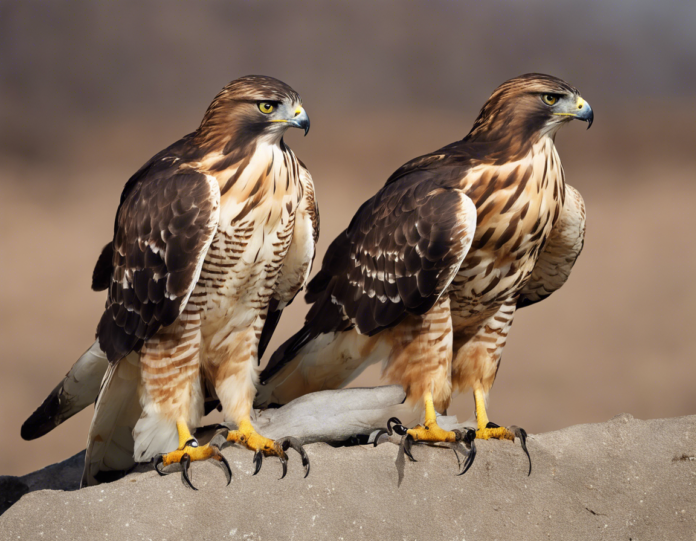Observing the majestic hawk birds soaring through the sky can be an exhilarating experience. These birds of prey are known for their keen eyesight, powerful talons, and impressive hunting skills. Hawks are found in various habitats across the globe, from forests and grasslands to mountains and deserts. Their diverse species exhibit unique characteristics and behaviors, making them a fascinating subject for birdwatchers and nature enthusiasts.
Identifying Hawk Birds
Hawks are raptors belonging to the family Accipitridae and are characterized by their sharp, hooked beaks, strong legs, and broad wings. When trying to identify hawk birds in the wild, there are several key features to look for:
Physical Appearance
- Size: Hawks come in various sizes, from the small Sharp-shinned Hawk to the large Red-tailed Hawk.
- Coloration: Their plumage can range from dark brown and black to gray and white, often with distinctive patterns and markings.
- Wingspan: Hawks typically have broad wings that allow them to soar and maneuver effectively.
- Tail Shape: The shape of the tail can vary among species, with some having rounded tails and others featuring notched or squared-off tails.
Behavior
- Flight Pattern: Hawks are known for their graceful and powerful flight, often soaring high in the sky on thermal updrafts.
- Hunting Techniques: These birds use their keen eyesight to spot prey from great distances and then swoop down to capture it with their sharp talons.
- Calls: Hawks communicate through a variety of vocalizations, including screeches, whistles, and screams, which can vary by species.
Common Hawk Species
There are numerous species of hawks found worldwide, each adapted to its specific environment and prey preferences:
1. Red-tailed Hawk
- One of the most recognizable hawks in North America.
- Identified by its rust-colored tail and pale underside.
- Often seen perched on fence posts or telephone poles while hunting.
2. Cooper’s Hawk
- Known for its agility and speed when pursuing prey through dense vegetation.
- Has a slate-gray back and reddish bars on its chest.
- Frequently found in wooded areas and suburban neighborhoods.
3. Broad-winged Hawk
- Migratory species that travels in large flocks during the fall.
- Recognized by its broad wings and reddish-brown barring on the breast.
- Prefers forested habitats and hunts small mammals and amphibians.
4. Ferruginous Hawk
- Largest hawk in North America with a distinctive rusty-colored plumage.
- Inhabits open grasslands and prairies, where it preys on rodents and small birds.
- Known for its fierce hunting prowess and powerful talons.
Spotting Hawks in the Wild
If you’re interested in spotting hawk birds in their natural habitat, there are a few key strategies you can employ:
1. Visit Prime Habitat
- Hawks are often found in open areas with good visibility and ample prey opportunities.
- Look for grasslands, farmlands, forests, and wetlands where hawks frequently hunt.
2. Scan the Skies
- Bring binoculars or a spotting scope to scan the skies for circling hawks.
- Look for birds soaring on updrafts or perched in prominent locations.
3. Listen for Vocalizations
- Hawks are noisy birds, especially during the breeding season.
- Listen for their distinctive calls and vocalizations to locate them more easily.
4. Observe Behavior
- Watch how hawks hunt, perch, and interact with other birds in their territory.
- Pay attention to their flight patterns and hunting techniques to learn more about their behavior.
Conservation of Hawk Birds
As apex predators, hawks play a crucial role in maintaining ecosystem balance by controlling populations of small mammals and birds. However, these magnificent birds face various threats, including habitat loss, pollution, and illegal hunting. Conservation efforts are underway to protect hawk species and their habitats through:
- Habitat Preservation: Preserving natural habitats and creating protected areas for hawks to thrive.
- Education and Outreach: Raising awareness about the importance of hawks in ecosystems and promoting responsible birdwatching practices.
- Legislation and Enforcement: Enforcing laws to prevent illegal hunting and trade of hawks and their feathers.
By supporting conservation initiatives and advocating for the protection of hawk birds, we can help ensure that these iconic raptors continue to grace our skies for generations to come.
Frequently Asked Questions (FAQs)
1. What is the difference between hawks and falcons?
Hawks belong to the family Accipitridae, while falcons are members of the Falconidae family. Falcons are known for their sharp talons and high-speed aerial pursuits, while hawks typically have broader wings and soar more frequently.
2. Are hawks endangered species?
While some species of hawks are considered endangered or threatened due to habitat loss and human activities, many hawk species are relatively stable in terms of population numbers.
3. Do hawks migrate?
Yes, many hawk species are migratory and travel long distances between their breeding and wintering grounds. They rely on favorable winds and thermals to assist them during migration.
4. How can I attract hawks to my backyard?
Providing suitable habitat, such as open spaces and perching opportunities, and offering food sources like small mammals and bird feeders can attract hawks to your backyard. However, be mindful of local regulations regarding feeding wildlife.
5. Can hawks be trained for falconry?
Yes, hawks are commonly used in falconry due to their hunting prowess and trainable nature. Falconers work with trained hawks for hunting small game like rabbits and birds.
Spotting hawk birds in the wild offers a thrilling glimpse into the world of these magnificent raptors. By learning to identify different hawk species, understanding their behaviors, and supporting conservation efforts, we can appreciate and protect these iconic birds for future generations to enjoy.

